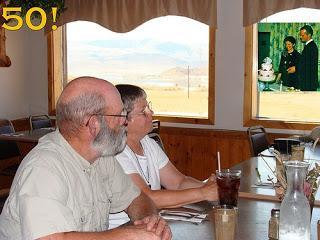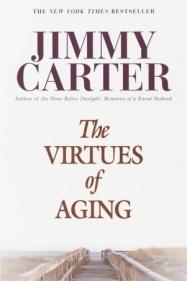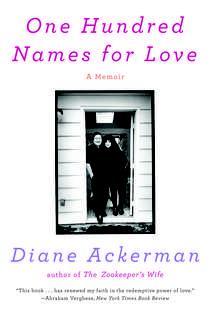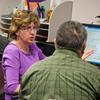
Photo by Martin LaBar.
The photo above shows a couple celebrating their 50th wedding anniversary. Behind them is a second photo of them on their wedding day--decades prior. I wonder, "How are they adapting to the aging process?" They have a lot of choices in how they behave, think and feel about aging. And we have a lot of choices in how we perceive them. Also, their unique life experiences might make some theories fit better than others.Gerontologists in particular have a lot of theories for explaining the aging process. Some of these theories are quite complex and/or are supported with data that only other experts can understand. Nevertheless, don't let the word "theory" send you running for the hills.
The average person employs a theory (a set of assumptions and concepts) for explaining aging--even if he or she isn't aware of it. Unless people make an effort to examine the complexities of aging and the diverse ways in which people age, it's easy to use stereotypes.
Even as a student of gerontology, it's important for me to examine the theoretical frameworks used to describe and interpret aging. I also need to remain open and flexible to adopting new theories. I am not going to be comprehensive or thorough here. Aren't you glad? But there are multiple frameworks.
For example, I was first motivated to study aging because I perceived older adults as growing more frail and dependent. In short, I was afraid. I soon learned my perceptions were filtered through a couple of models: biological degeneration (our bodies fall apart), exchange theory (we loose clout), and disengagement theory (we resign ourselves to decline and detach).
However, once I started working directly with older adults, I could better see through the filters of the activity model (people benefit from being socially and physically active for almost their entire life time), the social strata model (older adults create their own subculture to avoid the affects of ageism and to enjoy support from peers), and the cumulative advantage / disadvantage model (the rich old have a much different experience than the poor old).
But the three models that most interest me currently are these:
* Continuity Theory - We basically hold the same goals, values and personality over time. Student video.
* Selection, Optimization and Compensation (SOC) - As we experience roadblocks, we find ways to focus on what we're good at, maximize our strengths, and adjust to limitations.
* Gerotranscendence - We learn to accept losses, rise above the concerns that preoccupy us and focus on the benefits of life that transcend physical strength, financial gain, social status, fame, etc.
There are numerous examples of these theories, but let me use three books about midlife / late life aging issues as examples.



And even as I challenge you to examine your own theoretical frameworks, I also recognize the importance of just doing and being with other people. Yes, sometimes after a lot of research, I throw it all out the window and just laugh, sing, dance and embrace others. Gerontology for me is about a good mix of knowing, doing and being.
Related:
Books about Aging
Late Adulthood: A Time to Bless

